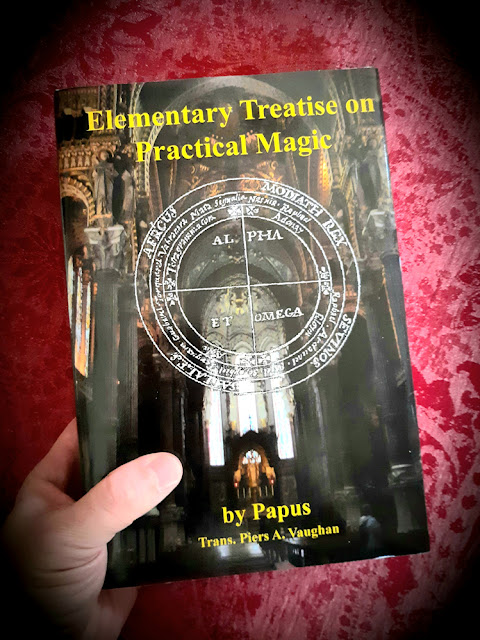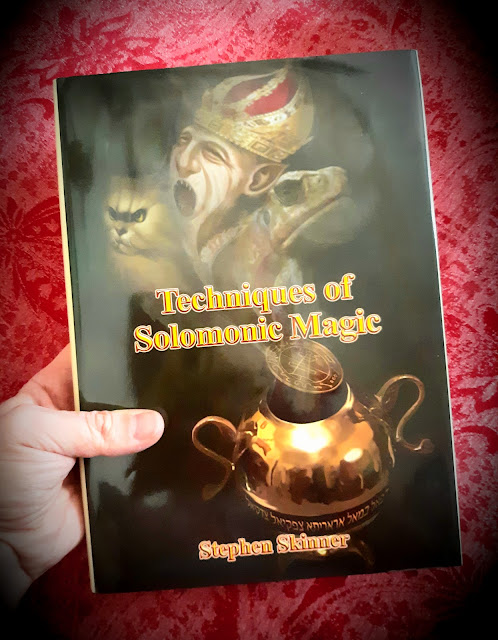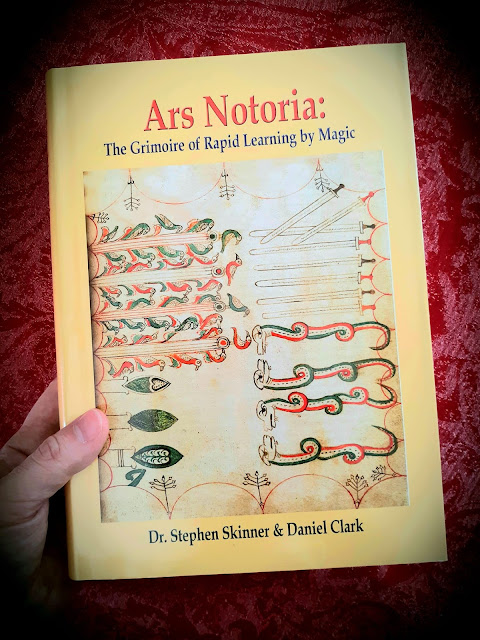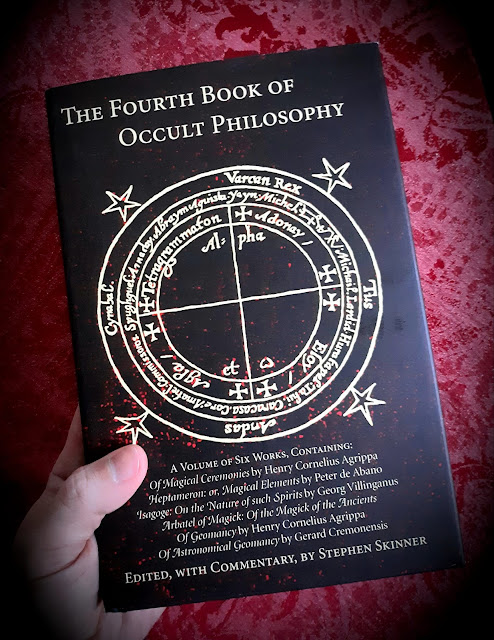 |
| The Keys to the Gateway of Magic. Dr Stephen Skinner. David Rankine. Occult. Grimoire |
I'm reading through "The Keys to the Gateway of Magic: Summoning the Solomonic Archangels and Demon Princes." Edited by Dr. Stephen Skinner and David Rankine.
 |
| The Keys to the Gateway of Magic. Dr Stephen Skinner. David Rankine. Occult. Grimoire |
This classic text of the Nine Great Keys details the invocation of the Archangels, the full hierarchy of spiritual beings (including Olympic Spirits and Elementals) and the evocation of the four Demon Princes.
Highly sought-after, this edition of a rare early seventeenth century grimioire has never before appeared in English. Occult scholar Stephen Skinner, along with magician and author David Rankine, trace the history of the Keys and offer full transcriptions of four key seventeenth century manuscripts in the British Library and in the Bodleian Library.
 |
| The Lesser Key of Solomon. Lemegeton Clavicula Salomonis. Grimoire. Joseph H. Peterson |
 |
| The Red Dragon. The Grand Grimoire. Black Letter Press. Occult. Ceremonial Magick |
The Grand Grimoire is a foundational book of magic from the 19th
century. This translation is the most accurate ever, and is presented
with parallel French & English text. A comprehensive introduction
covers the development of magic, the history of the grimoire, the witch
trials & the Inquisition, the themes & key insights, and much
more. The complete translation of a contemporary novel that provides
relevant social context to the grimoire is also included. The foreword
is by noted author and occultist Baal Kadmon.
This edition
incorporates the seals and images of the spirits of the Grand Grimoire,
many never seen before. This will aid the magician in concentration and
visualization of the spirits, so that they may be evoked for practical
purposes. The grimoire describes the process of evoking and making pacts
with Lucifuge Rofocale, the 'Infernal Prime Minister," who is above the
hierarchy of twenty-six other spirits in this book. The grimoire also
contains a process of necromancy and a collection of spells.
This
is a comprehensive resource for scholars, occultists, practicing
magicians, witches and wizards. It is a valuable work both for its
historical value, and its magical use. Our introduction contains notes
on the various items used in the Grimoire, such as the herb Verbena, the
Bloodstone, the Blasting Rod, and the Magic Circle. We have identified
the actual items referenced in the Grimoire, which will be a significant
leap in scholarship and magical practice, and we believe, give this
grimoire a reestablished significance in occult circles.
While
numerous translations exist, as this book is in the public domain, we
have not found any translations that have rigorously researched the
terms and translated all parts of the content, from the interspersed
Latin, Greek and the base French text. The authors are practicing
magicians and researchers.
From the Foreword by Baal Kadmon, "The
beauty of this translation is not only its accuracy, but also that it
is in a clear interlinear format. This provides the reader with the
opportunity to see the original text, side-by-side with the English
translation, something that does not exist in any other edition of this
text. This alone is an invaluable benefit to the reader. However, this
is not a mere translation of the text. It is also groundbreaking in its
scholarship. For centuries, certain items mentioned in the text were a
mystery. Aaman and Arundell were able to decipher them,which is a
historic achievement unto itself.Due to the nature of The Grand
Grimoire, accuracy should be of the utmost importance to any Magician
and Sorcerer who wishes to delve into the secrets and powers of this
text. You, the reader, can rest assured that this is by far the most
accurate rendition of this text to-date.I am confident that this book
will be referenced for many years to come. I know I will certainly refer
to it time and time again as I further my own research on the subject
of Solomonic Magic."
 |
| Elementary Treatise on Practical Magic. Papus. Gerard Encausse. Piers Vaughan |
 |
| Low Magick. Lon Milo DuQuette. Occult. Qabalah. Thelema. Ordo Templi Orientis |
 |
| The Veritable Key of Solomon. Clavicula Salomonis. Grimoire. Ceremonial Magick. Dr. Stephen Skinner. David Rankine |
 |
| The Magical Treatise of Solomon, or Hygromanteia. Grimoire. Ioannis Marathakis. Dr. Stephen Skinner |
 |
| Techniques of Solomonic Magic. Hygromanteia. Key of Solomon. Goetia. by Dr. Stephen Skinner |
 |
| Tarot of Ceremonial Magick. Lon Milo DuQuette. Astrology, Enochian Magick and Goetia |
This particular Tarot deck was out of print for a very long time and has been hard to find. So, when I learned that Lon was working with an Occult store in Nebraska to reprint the deck, I figured I'd get one while they were still available. Order while you can.
 |
| The Sworn Book of Honorius. Liber Iuratus Honorii. Honorius of Thebes. Translated by Joseph Peterson |
 |
| The Science of the Kabbalah. Lazare Lenain. Translated by Piers Vaughan. Portrait by Travis Simpkins |
Purchase the book here:
 |
| The Greek Magical Papyri. by Hans Dieter Betz. Techniques of Graeco-Egyptian Magic. by Stephen Skinner |
 |
| Ars Notoria. The Grimoire of Rapid Learning by Magic. Dr. Stephen Skinner. Daniel Clark |
 |
| The Key to Solomon's Key. Lon Milo DuQuette. Knights Templar. Freemasonry. Goetia. Ceremonial Magick |
 |
| The Three Magical Books of Solomon. Greater Key. Lesser Key. Goetia. SL MacGregor Mathers. Aleister Crowley |
 |
| Fourth Book of Occult Philosophy. Henry Cornelius Agrippa. Edited by Stephen Skinner |
 |
| Three Books of Occult Philosophy. Henry Cornelius Agrippa. Edited by Donald Tyson. Llewellyn Publications |
 |
| The Order. Magic Secret Society. Netflix Series. Sarah Grey as Alyssa Drake |
 |
| The Order. Magic Secret Society. Netflix Series. Sarah Grey as Alyssa Drake |
 |
| The Order. Magic Secret Society. Netflix Series. Sarah Grey as Alyssa Drake |
 |
| The Order. Magic Secret Society. Netflix Series. |
 |
| The Order. Magic Secret Society. Netflix Series. Sarah Grey as Alyssa Drake |
 |
| The Order. Magic Secret Society. Netflix Series. |
 |
| The Order. Magic Secret Society. Netflix Series. Sarah Grey as Alyssa Drake |
 |
| The Order. Magic Secret Society. Netflix Series. |
 |
| The Order. Magic Secret Society. Netflix Series. |
 |
| The Order. Magic Secret Society. Netflix Series. |
 |
| The Order. Magic Secret Society. Netflix Series. |
 |
| The Order. Magic Secret Society. Netflix Series. Louriza Tronco as Gabrielle |
 |
| The Order. Magic Secret Society. Netflix Series. |
 |
| The Order. Magic Secret Society. Netflix Series. Sarah Grey as Alyssa Drake |
 |
| The Order. Magic Secret Society. Netflix Series. |
 |
| The Order. Magic Secret Society. Netflix Series. |
 |
| The Order. Magic Secret Society. Netflix Series. |
 |
| The Order. Magic Secret Society. Netflix Series. Sarah Grey as Alyssa Drake |
 |
| The Order. Magic Secret Society. Netflix Series. |
 |
| The Order. Magic Secret Society. Netflix Series. |
 |
| The Order. Magic Secret Society. Netflix Series. |
 |
| The Order. Magic Secret Society. Netflix Series. Sarah Grey as Alyssa Drake |
 |
| The Order. Magic Secret Society. Netflix Series. Sarah Grey as Alyssa Drake |
 |
| The Order. Magic Secret Society. Netflix Series. Sarah Grey as Alyssa Drake |
 |
| The Order. Magic Secret Society. Netflix Series. Sarah Grey as Alyssa Drake |
 |
| The Order. Magic Secret Society. Netflix Series. Sarah Grey as Alyssa Drake |
 |
| The Order. Magic Secret Society. Netflix Series. |
 |
| The Order. Magic Secret Society. Netflix Series. Louriza Tronco as Gabrielle |
 |
| The Order. Magic Secret Society. Netflix Series. |
 |
| The Order. Magic Secret Society. Netflix Series. Sarah Grey as Alyssa Drake |
 |
| The Order. Magic Secret Society. Netflix Series. |
 |
| The Order. Magic Secret Society. Netflix Series. Sarah Grey as Alyssa Drake |
 |
| The Order. Magic Secret Society. Netflix Series. |